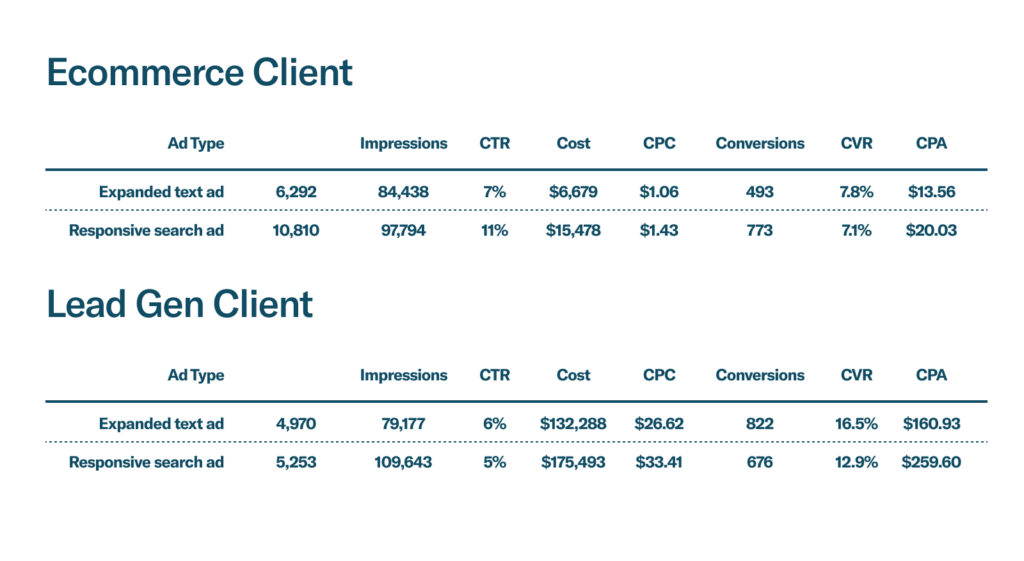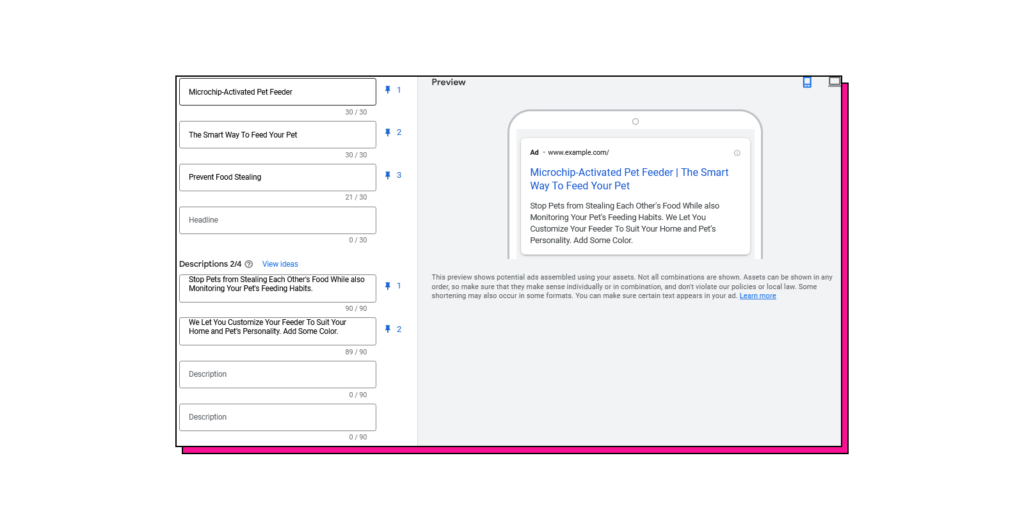Last summer, Google discontinued support for expanded text ads (ETAs). This move marked a major transition for many marketers—one that essentially forces paid search experts to transition their search text ads to the responsive search ads (RSAs) template.
While there are benefits to this transition, we’ve been seeing marketers struggle with ad performance following the switch. In this post, we’ll take a look at why this is and offer some new best practices for moving forward.
Background on the ETA-to-RSA Transition
On June 30, 2022, marketers lost the ability to create or edit ETAs (although Google continues to serve existing ETAs under a grandfather clause). In making this change, Google’s goal was to transition marketers from ETAs to RSAs. While ETAs can have only 3 headlines and 2 descriptions, an RSA can have up to 15 headlines and 4 descriptions. Overall, RSAs represent a more automated and flexible approach to new ad creative—but they’re not without their challenges.
While RSAs have been available for quite some time (since 2018, in fact), there have been ongoing issues with this forced transition as it pertains to data reporting and ad copy testing. In addition, marketers can expect some declines to performance KPIs, as seen in the two examples below:

Ever since RSAs were introduced, Google’s algorithm has shown favoritism to RSA ad copy compared to the ETA format. This can be seen in the examples above, which demonstrate much higher impression, click and cost totals for RSAs, despite there being a significantly higher count of ETAs running in each ad group. While CTRs and conversion totals do vary in each of the examples, a few things are clear: CPCs and CPAs are more costly for RSAs, and conversion rates are lower compared to the ETA counterparts.
Finally, perhaps the biggest challenge with RSAs is reporting on their data. Since there are so many headline and description combinations (43,000 variations), Google doesn’t have a simplistic way to report on data beyond impression count, which is extremely frustrating. However, there are a few workarounds that can be implemented to remove some of the headaches this change has caused.
The Benefits of Google’s Shift to RSAs
While Google’s default to RSAs does seem frustrating at first glance, it’s not unexpected or unprecedented for Google to make such a move. (The company did a similar switch from text ads to ETAs back around 2018.) Google’s assumed goal with this change is yet another shift toward automation, machine learning, and streamlined account management. While many advertisers feel this gives them less control over their campaigns, Google takes the stance that machine learning can improve campaign performance in terms of flexibility, clicks, and conversions.
One clear benefit of RSAs is time management. In the past, writing ad copy could be tedious and time-consuming work, as you needed to create multiple ads per ad group, while also making sure your message was relevant to the grouped themes. In addition, you could really use only a fraction of ad copy ideas per ad group before things got too messy and convoluted to gain any real learnings.
With RSAs, some of the tedium and work time will be cut down, as you will no longer need to create numerous lines of ad copy as was done in the past. Additionally, you can test many more headline and description combinations per each RSA, making it highly appealing from a creative perspective.
Establishing New Best Practices with RSAs
Now comes the hard part: as with so many of the changes Google has made in the past, marketers now need to adapt, test, learn, and ultimately establish new best practices to overcome any obstacles encountered due to the shift.
Don’t panic, existing ETA’s will continue to serve
As mentioned before, Google’s transition to RSAs as the default puts a few obstacles in the way when we consider future performance, ad copy testing and reporting. Luckily, existing ETAs continue to serve. (They just can’t be edited.) This is helpful from a short-term perspective because it means marketers don’t have to suddenly transition fully to RSAs without preparation. However, current ETAs and destination landing pages will eventually become stale, meaning performance will decline and marketers will be forced to pause them.
In other words, whether we like it or not, a full transition to RSAs does need to happen over time. However, there are a few workarounds we can put in place to help maintain performance.
Pin Headlines & Descriptions to Control Order of Ad Copy
The biggest workaround—one that addresses several of the issues caused by the forced RSA transition—is pinning headlines and descriptions to control the order of ad copy. While Google will claim that this method is against best practices, there is no real rule saying that we need to use all 15 headlines and all 4 description lines.
The caveat of this though, if marketers take this approach, is Google will give the ad copy a Poor Score in the ad strength. Google’s measurement on ad strength is an indication of the relevance and diversity of your ad combinations, but people using this workaround, in this case, should ignore the ad strength score, for purposes of testing this tactic against “actual” performance.

A/B Test RSAs Against Top-Performing Live ETAs
We can also consider A/B testing RSAs against the top-performing live ETAs, duplicating the standard 3-headline, 2-description-line ads, and pinning them identically to the order of the original ad (example below).
Original ETA

RSA Workaround

This test could prove beneficial by enabling marketers to see Google’s favorability toward RSAs in terms of impression frequency, while also gaining better insights in terms of performance.
Another reason to limit the number of headlines and descriptions, and to pin them in a specific order, is due to the limited reporting Google currently has in place. As mentioned, the Google Ads platform only provides impression-level data for RSA assets and their combinations, which is troublesome from an ad copy testing standpoint. (Sure, we will be able to see the allocation of impression numbers per combination, but we cannot tell a story on performance based on assumptions.)
However, if we are willing to sacrifice the initial data reporting aspect of launching RSAs using all 15 headlines and all 4 description lines, we can still use Google’s machine learning to focus on the few optimal combinations of ad copy (again, 43,000 variations!). Unfortunately, this approach will require time to accrue adequate data. But from those top combinations, we can then begin to break out ads into the truncated RSA workaround, mentioned above, to isolate performance data in a more structured way.
In conclusion, a full transition to RSAs will take time and patience before we can really trust in a single set of best practices. However, by getting clever with workarounds and continuing to test different approaches, we can avoid certain headaches, especially from a data reporting perspective.
At Anagram, we love testing new approaches to help clients overcome challenges and drive improved conversions and ROI. Need help navigating recent changes in paid search and other vital advertising channels? We’re here to help!


